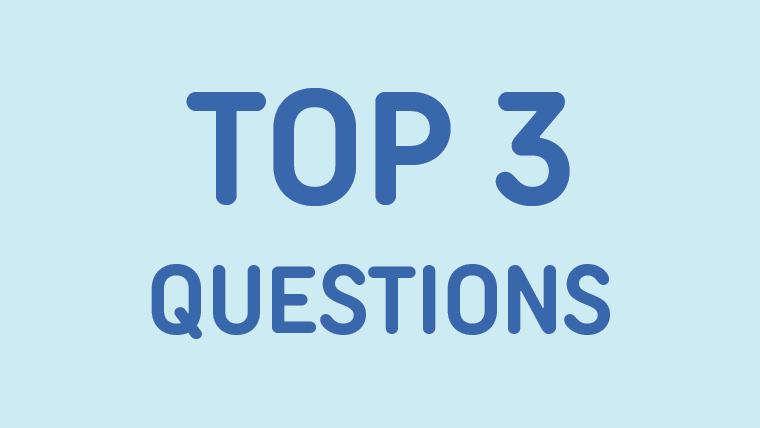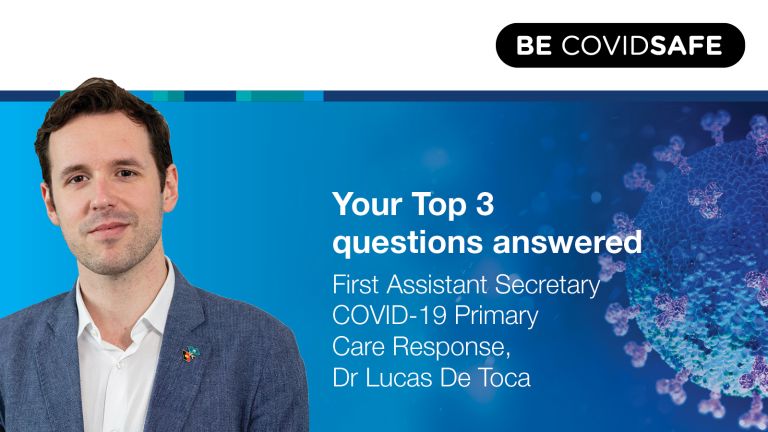
Hello. I’m Dr Lucas De Toca and I’m on Ngunnawal country, on Ngunnawal dhaura. I lead the rollout of the vaccine through GPS, pharmacies and Aboriginal Health Services for the Australian Government and today I’m going to be answering three of your top questions in our social media channels. We are going to talk about re-opening international borders, two versus three doses and we’re going to talk about vaccine in children younger than five years of age.
The first question today, is about the re-opening of the international border. There’s been some gradual re-opening as part of the National Cabinet’s plan to re-open Australia, but 21 February is when the border will be open to most visa holders and Australia will be effectively re-opened to the rest of the world. And some people have expressed concerns about what that means for their health and their wellbeing after, for the last over two years now, international borders have played a significant role in keeping us all safe. The importance is that the re-opening of the border that has been agreed by the National Cabinet, is in the context of what the epidemiology of COVID-19 means in our country now versus what it was a couple of years ago when the border, the hard borders were put in place. Our lives have changed enormously, but so has the virus and the epidemic. We’ve gone from a more viral and more severe disease that we were trying to contain, to a slightly less severe, or milder definitely for vaccinated people, variant that is more transmissible and now it’s frankly here and affecting over two million people on their first month and a half of this year alone. So the reality is that the COVID-19 risk equation and the risk and benefits posed by the closed border has changed dramatically. We are one of the most vaccinated nations in the world, which means that the immense majority of our country is well protected against severe disease, hospitalisation and death. We also have new ways of managing COVID-19. We have oral treatments now available that are being rolled out primarily through residential Educare facilities and Aboriginal Health Services and state and territories for the hospital system, but even in addition to the protection we get from vaccines, we now have therapeutics that will help us minimise the risk of severe disease, hospitalisation and death. We have a society that is very well accustomed to frequent hand-washing, maintaining physical distancing, wearing masks if indoors or in crowded spaces, and generally do all the COVID-safe behaviours including staying at home and getting tested if you have symptoms, no matter how mild they are. All of these things together, and the fact that we have a large amount of circulating COVID-19 in the country at the moment, mean that the risk and benefit of having something as severe as an international border closure has shifted. And the importance of families being reunited, Australians travelling, people coming and visiting from overseas, is also an important consideration in that risk-based decision-making. The risk of international arrivals coming into Australia, versus the risk we currently have with ongoing domestic transmission, is very different to what we had last year, or even a few months ago and that’s what informs that decision. Ultimately, as an individual, if you ensure that you are up-to-date with your vaccination, you have your booster, if it’s been more than three months since your primary course, your second dose and you keep doing COVID-safe behaviours, maintaining physical distancing and following mask advice wherever you are in your jurisdictions, you are still minimising your risk as we slowly move towards a sense of normalcy in this pandemic reality that we now have.
Related to this, the question is, why is the requirement to cross the border still two doses for most people, whereas in Australia we talk about three doses to stay up-to-date? Is that fair or is that consistent? Think, it’s important to realise that the advice on how to stay up-to-date that ATAGI, the Australian Technical Advisory Group on Immunisation has provided, is clinical guidance for people in Australia on how they can be as protected as they can, against COVID-19. It advises what the optimal status for someone to be in their COVID-19 vaccination in order to achieve maximum protection. And to do that, it’s recommended that people do the primary course, two doses of COVID-19 approved vaccines and then three months after their second dose, get their booster. It’s strongly recommended that people don’t wait more than six months after their second dose and they would be considered overdue or not up-to-date after that. That’s domestic advice, that’s to inform providers on what to recommend their patients and that’s to advise you, advise me what it is that we can do to be maximally protected. That’s different to a risk assessment of, that is done on what are their requirements to cross a border. And the medical advice provided to government, is that in the current context, in the current epidemiology in Australia and the fact that we are an exceedingly highly vaccinated nation, one of the most vaccinated countries on Earth, the risk posed by international travellers is sufficiently reduced with a full course of vaccination or with two doses of our TGA-approved or recognised vaccine. It’s also important to note, that many countries do not have booster programs that are as open and available as the Australian one, so there would be an impact on returning Australians if there was a booster requirement that means people who live in a country where a booster is not available, would not be able to return. All in all, again in public health and public health policy-making, risk assessment and risk-based decision analyses are made and the fact that we are so well protected with vaccine here that our booster rate continues to grow, that we have significant circulation of COVID-19 in the country already and the availability of boosters internationally or lack thereof in some places, means that the advice on what is required to cross the border remains as two doses for most cases, or one dose of the J&J vaccine. And that’s an important distinction. Ultimately, after people cross that border they will be subject to the same requirements that everyone else has here. So if you’re in a state or territory, working for a profession that requires a booster as part of that, that would still apply, even if their requirement for crossing the border was only two doses and that’s the distinction. Clinical advice for domestic application, versus a risk assessment that would happens at the border. It’s hard to keep up sometimes, we absolutely acknowledge that.
Final question, as we see the numbers of five to 11-year-olds getting vaccinated continue to increase, we’re nearly at half of the entire five to 11 population in the country having already received one dose, people are asking, what happens with younger kids? What happens with under 5s? Are they getting the vaccine? So under 5s are currently the last cohort remaining in Australia to be eligible for a vaccine. There’s more than 24 million people in Australia that are eligible for vaccination and just the zero to four-year-olds are the ones that are not eligible. They’re a number of trials underway at the moment to test the current vaccines, particularly Pfizer and Moderna in kids younger than five. The Pfizer vaccine for five to 11s is a smaller dose than that for 12 years and over. It’s about a third, actually a third of the adult dose. And Pfizer is trialling an even lower dose for kids under five, between six months of age and under five. Those trials are ongoing and we will continue to monitor them very closely and when the trials are finalised and our regulators get an opportunity to assess what the results of those trials are, then we’ll have recommendations, if appropriate, on the use of those vaccines in younger people. Moderna is conducting similar trials for younger cohorts as well, and we will be very actively monitoring that. In the meantime, the best thing that we can do to protect younger kids, noting that of course the risk of severe disease is lower than older people, is to make sure that everyone around them is vaccinated, so their older siblings five years and over are vaccinated, their parents and uncles and aunties and everyone else around them is vaccinated, and that we continue to practice COVID-safe behaviours to minimise our risk of transmission. Physical distancing, frequent hand-washing, masks when indoors and if you have symptoms, you know the drill, no matter how mild, please stay home, get a test and wait until you get a negative result before mixing back again with others.
That’s all we have for today. As always, thanks for watching, and for staying COVID-safe. Thank you.
Top 3 questions
- I’m feeling anxious about international borders re-opening and people possibly returning with new strains of the virus, what things can I do to alleviate my concerns?
- Why are Australians being encouraged to be triple vaccinated, when people arriving from overseas need only two doses?
- Why aren’t kids younger than 5 able to get vaccinated yet?








